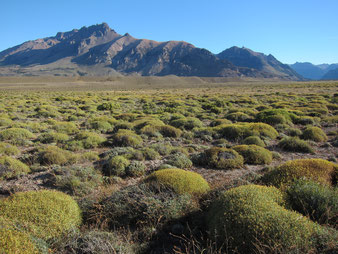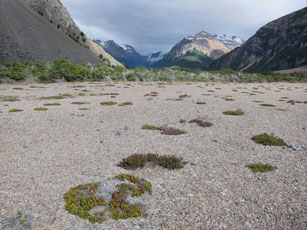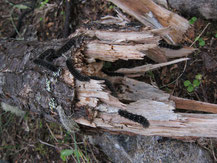There it went. One of my bathing shoes was going down the river. The flow was quite fast here. No chance to react… That’s what happened on the first, relatively easy river crossing on my trek through the Lago Jeinimeni natural reserve. My fault, why would someone rely on bathing shoes with a worn-out velcro fastener on such a trip? Anyway! No big deal, was it? I mean it should be possible to cross the next river with just one shoe, wouldn’t it? I did not really know all details of my further route though…
The pampa
It all started with a 4-hour bus ride from Puerto Rio Tranquilo to Chile Chico on a spectacular road following the southern shore of the Lago General Carrera. Getting one of the seats in this bus, which are preferentially sold to local residents, was the first big drama, but this is another story… From Chile Chico, I tried to organize a transport to the entrance of the Lago Jeinimeni nature reserve, which can be reached on a 52 km long dead-end dirt road only. Unfortunately, CONAF, the Chilean National Forest Corporation, did not want to give me a ride. Since it was also not possible to find other tourists heading towards Jeinimeni, I decided to try my luck hitchhiking. Incredibly, the first car stopped after I’ve been waiting at the start of the dirt road for five minutes only!
But this was the end of my lucky streak… Suddenly, after he had seen a shepherd on the roadside, the driver stopped. “It’s just 8 km to walk to the entrance from here”, he told me. His wife looked a little skeptical though. I was sure this was not the truth, but which choice did I have? The mountains could just be spotted at the horizon – still quite far away. I found myself in the middle of the pampa, right next to the border to Argentina. Well, there was no other possibility than walking the rest of the dirt road. After some hundred meters, I passed a little sign on the right: km 26…
But which were my options? Going back would involve the same distance as going on. I still had some hope for another car to pick me up, but it turned out that really few were going here: I think in total there were three more cars during that day, two of which in the opposite direction, the other one was fully occupied (or pretended to be). So I walked on, following that endlessly straight road, the mountains coming closer very slowly. Strong headwinds didn’t make it easier, but the biggest problem was the complete lack of shade. The pampa was completely treeless and dry. At least I passed a river every five to ten kilometers.
In total, I had planned for a five-day trek, including one more-or-less rest day. But from the park entrance, of course. The idea was to cross the Lago Jeinimeni reserve and heading towards Valle Chacabuco in the future Patagonia National Park. A true traverse of this remote mountain range. But now, all these plans had taken a surprising turn, and I ended up sacrificing my “rest day” on the very first day of the trek. Of a trek, which I was not even entirely sure about how long it would take. Thematic maps of this area were unavailable, so I had decided to rely on a distorted screenshot of a map in progress which I could find online.
All in all, this was not exactly the start I had hoped for. My mood got worse when I somehow destroyed my t-shirt while removing my backpack. Nevertheless, I managed to get very close to the park entrance that day, but had to stop about two kilometers ahead of it when it got dark. Right before I had met the CONAF ranger in his jeep on the way home… My feet hurt from the gravel. I was unsure if this was all worth it. In retrospect, I have to say: Yes, absolutely!
The water wonderland
Even in the pampa, although mostly a monotonous landscape, there have been some highlights: beautiful tufts of grass along the way and incredible rock formations in the distance. But as soon as I reached the lake lending its name to the entire reserve, the scenery completely changed: Water everywhere, fed by glaciers I could spot on top of the mountainous landscape in the distance. The light blue Lago Jeinimeni was followed by the indeed perfectly turquoise green colored Lago Verde. From the ridge above Lago Verde, I had a first glimpse of the Valle Hermoso, which was now waiting ahead of me. The name says it all. Meandering and widely branched rivers reminded me of valley landscapes characteristic for the Arctic.
I was a little late that day, since I had decreased my pace after the tiring first day and the trails were quite demanding, although from time to time marked. Already from above I was unsure about my chances to cross the different river arms close to their inflow into Lago Verde. Due to the immediately adjacent rock faces, it was even necessary to walk a little through the lake at the beginning. After reaching the riverbed next to the apparently largest river branch, I was stuck. I tried to cross the river: As soon as it turned out to be at least waist deep, I turned. Relying on only one remaining bathing shoe did not make it any easier. I tried to walk on following the riverbank: It was completely covered by incredibly dense vegetation, roots and fallen trees everywhere. And here I saw them for the first time also: Huge numbers of caterpillars! However, in this moment this did not bother me too much. I had another try crossing the river: Definitely not safe!
Finally, I decided that my best option was to stay here for the night. Chances to cross might be higher in the next morning. Going a little back was also unsuitable, since there hasn’t been any plain area for my tent in the last hours. Unfortunately, all the area where I could pitch my tent here was covered by sand. Not the best ground… Especially not if the Patagonian wind awakes during the night!!! What followed was by far the worst night I ever spent in a tent. I think I had to get up a dozen times after the head end of my tent was literally gone with the wind again.
I had marked the water level in the evening. And indeed, it was a little lower the next morning. Finally, I managed the crossing! Thinking about it later, maybe it would have been smarter to try it directly at the confluence of the river arm in the lake, but also there it was not guaranteed to be much easier. Walking through Valle Hermoso was wonderful, but turned out to be the most strenuous part of the trek. Even after I passed all the separate river branches in the estuary, the meandering river forced me to cross it over and over again. This was not the most pleasant thing to do with just one bathing shoe in the cold water fed by the surrounding glaciers. Unfortunately, extremely dense shrubland was always directly adjacent to the stream, and walking there was no better alternative either. In total, it must have been around 20 times that I had to take off my hiking boots for the next crossing. It might be a good idea to take an additional pair of running shoes for this trek.
The caterpillar pest
At the latest when leaving Valle Hermoso southwards, it became obvious that the entire forest was infested by a caterpillar pest. All the leaves had been fallen victim to these little monsters. They were simply everywhere; on my trousers, even in my tent – like in a horror movie! I became disgusted by their constant presence. The leafless trees created a somewhat surreal and gloomy atmosphere.
The trail went on into Valle Avilés, leading southwards towards Valle Chacabuco. I increased my pace in order to leave the dead forest as soon as possible, and of course it was also time to finish the trek. Valle Avilés turned out to be an extremely elongated valley, and despite fast walking it took me one and a half days to reach its end. Getting closer to my destination, the landscape changed again: The forest was replaced by open grassland. Later I crossed a breathtaking hanging rope bridge spanning over a probably 50-meter-deep canyon. As I’m a little scared of heights, I could feel my heart beating faster than usual here. I even had a first test run without the backpack, and sudden gusts of Patagonian wind didn’t make me feel more comfortable.
I arrived at a campsite under construction in Valle Chacabuco late in the evening. From here, I hoped for some transport to Cochrane (the nearest town) or the visitor center of the Patagonia Park. However, at this time no cars were going anymore since I had missed the construction workers on their way home. But in the next morning, by chance I had the pleasure to meet Kris Tompkins, former businesswoman but today conservationist. Together with her husband Douglas Tompkins, she established large conservation areas in South America, the creation of a Patagonian National Park being their biggest project. This park is intended to connect Valle Chacabuco, an important habitat for the endangered huemul deer, with the surrounding national reserves of Jeinimeni and Tamango. We were unsure if the forest would be able to recover from the impacts of the caterpillar infestation. Probably increased winter temperatures lead to an exceptionally high survival rate of larvaes, followed by epidemics in summer if climate remains favorable during the course of the year. I’m especially interested in such forest mortality events, since this is closely related to my work as a researcher.
This adventure ended by a ride with a friendly local jeep driver to Patagonia Park’s visitor center. The beauty, diversity and remoteness of the landscape made this trek to one of my greatest outdoor experiences. After the park entrance at Lago Jeinimeni, I had seen only one other hiker during the following four days. My tour through this isolated place in the transition zone between dense mountain forest and pampa proved to be the wildest and probably toughest trek I did so far. But also one of the most rewarding ones. I can definitely say it’s the one I still remember most. Interestingly, after it had been a little reshaped by the wind, I can now put together my tent much more easily than before…




















There are no comments yet.